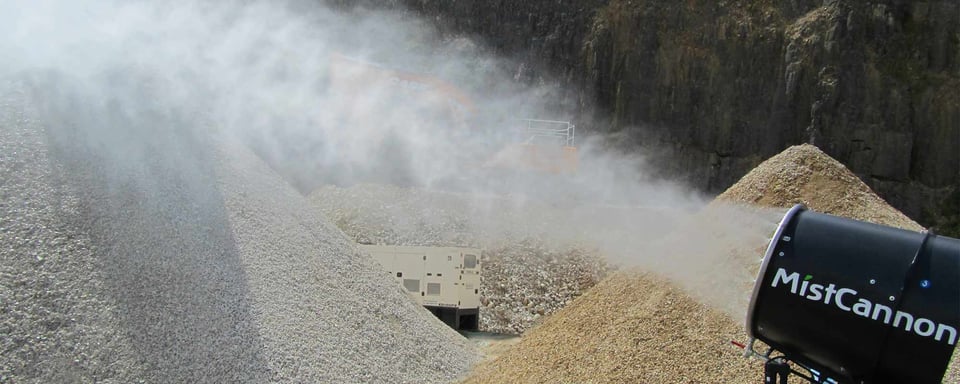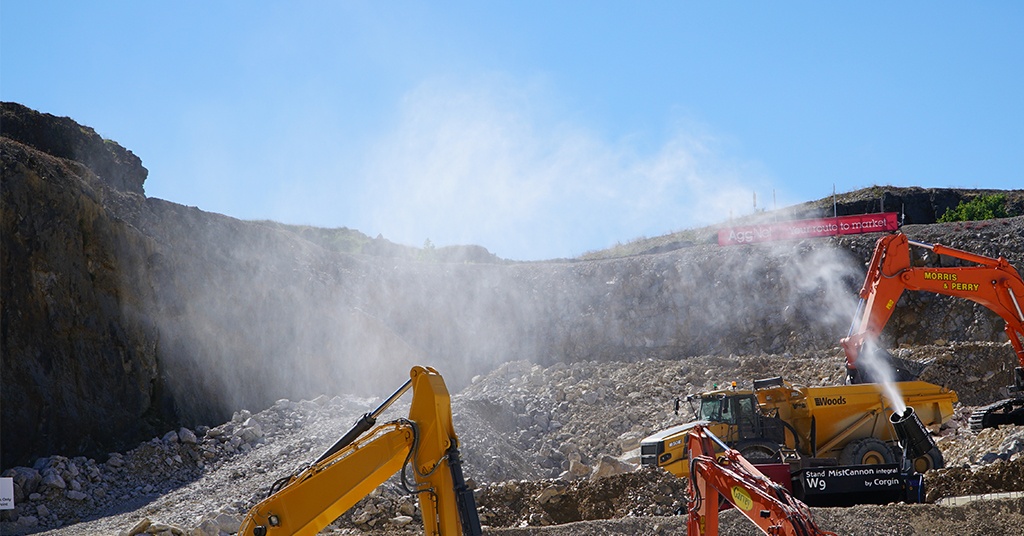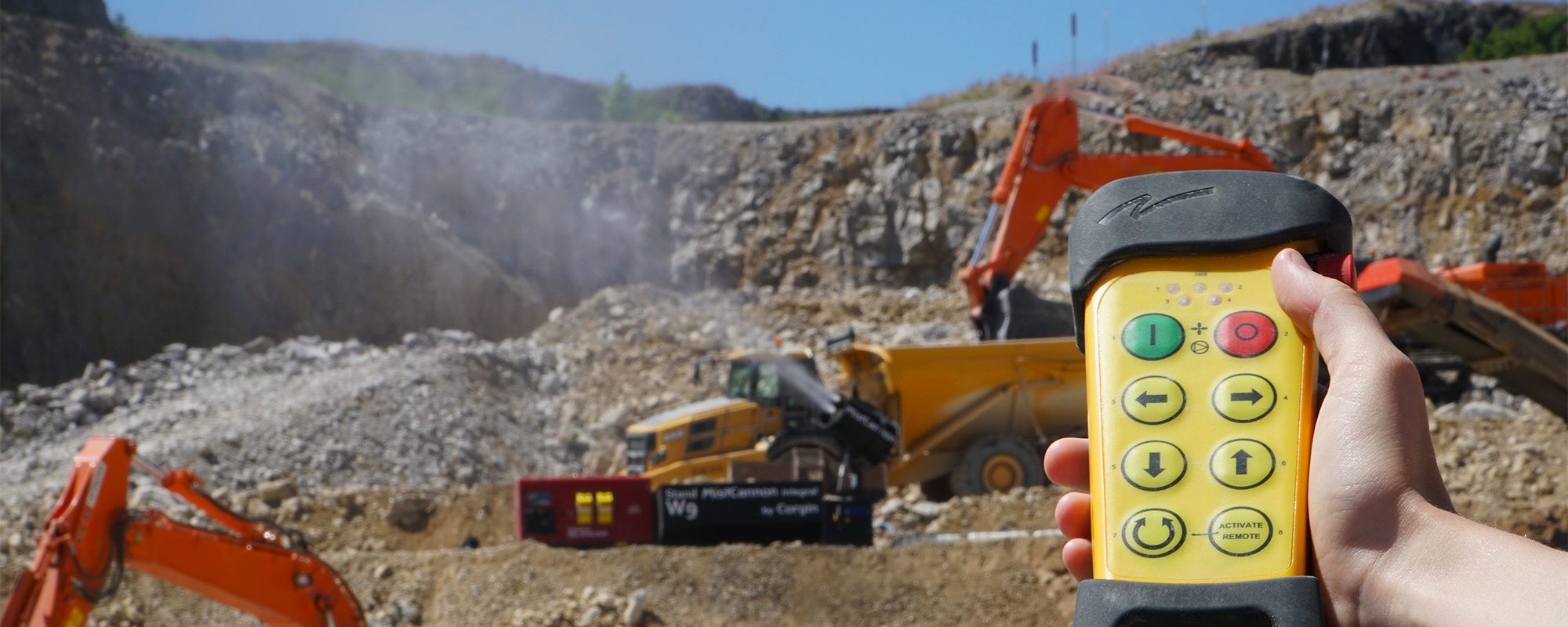Are you looking to hire or buy a dust cannon to help control dust emissions, but don’t know where to start? Firstly, to explain, by the term ‘dust cannon’ we’re referring generically to mobile dust suppression units which project a spray of water droplets to suppress dust emissions. Some people use the generic term fog cannon and at Corgin we coined the name MistCannon when we launched our own range in 2012 as part of our line-up of mobile dust suppression units.
We understand that one of the fundamental questions serious buyers and hirers want to know is how much they are going to cost. Yes, price is certainly not everything, but it is important for anyone sourcing or specifying dust cannons to know what budget they need to allow, and what they will get for their money.
In this article we’ll attempt to give some realistic price ranges for dust cannons available in the market and aim to give an unbiased explanation about what drives costs.
As you can imagine, dust cannons can come in a wide variety of sizes and specifications. In our experience the cost to buy a unit can range from £3,600 to £80,000, and the cost to hire between £150 and £1,300 per week.
Clearly these price ranges are huge, so let’s take a look at the main factors which we’ve found have an impact on prices:
- Specification
- Supplier Support Level
- Availability and Speed of Supply
- Hire Term
- Delivery
Let’s drill into each of these factors:
1. Specification
As with many products, there is great diversity in terms of different specifications of product available on the market. We find that the size of the dust cannon has the most impact on the price, followed by whether it's self-contained, what performance it offers, the quality of build, and what additional features it has.
Size
The size of unit required clearly has a big impact on price. By size we are referring to the water throw range provided by the unit and this will need to be determined by the size of the dust source you are targeting. For localised dust sources you will need a much smaller unit than for a widespread dust source. Clearly, the greater the range and coverage provided, the higher the cost of the unit. As a guide, for a standalone dust cannon which you have to connect directly to your own electrical power and water supply, can expect to pay from £3,600 for a shorter throw range (e.g. 10m) unit up to £22,000 for a longer throw range (e.g. 80m) unit. To hire, the price range is commonly between £150 and £1,000 per week, again depending on the throw range.
Self-Contained
Many users find that directly-connected standalone units with trailing cables and hoses are often not convenient, and are certainly not an option on sites without power and water supplies nearby. For this reason, many need a self-contained dust cannon on a highly mobile, trailer-mounted unit with its own onboard water tank and power source (e.g. generator) and we’ve found that this tends to drive up costs the most. For example, the cost of purchasing a trailer-mounted ‘dust cannon’ with onboard water tank and power source can typically range between £10,000 for the smallest (e.g. 10m throw range) units up to £80,000 for a large, trailer-mounted unit with massive 5,000 to 10,000 litre tank (or baffled tank) and onboard generator large enough to supply a long range (e.g. 80m) oscillating cannon. To hire you’re talking of a range between £250 and £1,300 per week.
Performance
While the size and the self-contained factor have the most impact on the cost of dust cannons, there are a number of factors relating to the specification which will have an impact too. Performance is certainly one of those. When we say ‘performance’ you might ask, “don’t they all suppress dust?” The answer is, yes, but in reality, performance can vary significantly and if a price seems too good to be true compared to others, then it probably is!
Some of the most significant contributors to performance are the volume and size of dispersed water droplets and the fan motor power. Other factors such as the cowl design will also influence performance, especially the larger throw range units. Larger and/or higher specification pumps and fan motors will be required to optimise the quality of spray and throw range. However, higher performance units will not only achieve the stated throw range with less susceptibility to wind interference, but they will also cope with intensive or large-scale dust emissions much more effectively, with much quicker knockdown. Dust suppression is a constant battle and underpowered dust cannons risk being overpowered by the dust rather than vice versa! A simple way to check the fan performance is the motor power rating, or even better, the airflow (measured in m/s) and air pressure (measured in Pa) induced by the fan.
A common misconception relates to the difference between dust cannons and mobile ‘rotary atomisers’. They’re commonly confused because there are similarities in appearance but they’re two completely different animals in terms of fan power and water consumption: think tiger versus domestic cat! A rotary atomiser typically outputs between 0.2 – 3.0 litres per minute of water; a dust cannon is likely to be more in the region of 20 – 40 litres per minute. Similarly, a rotary atomiser fan motor is typically around 0.5kW and a dust cannon fan motor anywhere between 3kW and 45kW or more! Confusing the two might mean you get a far inferior performance to what you were expecting!
Build Quality and Reliability
The old saying “you get what you pay for” applies to mobile dust suppression equipment as it does to anything, and build quality and reliability is important if you want the equipment to endure continuous use on industrial or construction sites. Ask the supplier if you can see the product in action or ask them if you can contact other users so you can get a reference. Speaking to other users is particularly useful because they’ll tell you not only about the build quality and performance of the product in real life applications, but the level of support from the supplier as well.
Other Features
Other cost varying features include wheel sets (for non-self-contained units), automatic oscillation, auto-drain to prevent frost damage, adjustable nozzle output and remote-control handsets - all features that may be useful to you but will cost extra. As an example, a remote-control handset can cost between £1000 and £2000 extra depending on the specification.
2. Supplier Support Level
Supplier support, whether it’s to advise you in selecting the right equipment for your site or provide aftersales backup, usually involves having qualified support staff who are readily available when you need them - this comes at a cost. Consequently, this may be reflected in the pricing of suppliers who provide this from suppliers who provide quality design input and after-sales support. Non-specialist suppliers who only offer dust cannons as part of a broad range of offerings often struggle to provide this level of support. Others simply skimp on it and ‘don’t want to know’ when things go wrong. However, mishaps happen and all mechanical equipment – even the best and most powerful – is susceptible to damage or failure at times. When that happens and when downtime is costing you money, many users find that the speed and reliability of the supplier’s response is worth paying extra for.
3. Availability and Speed of Supply
For users whose site operations can be jeopardized by dust emissions, availability of dust suppression equipment and the speed of delivery is important and valuable. Suppliers who invest in stocks of dust cannons and offer a quick turnaround to ensure rapid and reliable supply for their customers will typically have higher costs to cover and will likely need to charge more than others who cannot provide the same service.
4. Hire Term
Where you’re hiring equipment, the utilisation rate, i.e. what proportion of time the equipment is out on hire, will significantly impact the hire rates charged by the supplier. A high utilisation rate means that the investment costs can be recovered more quickly. The demand for dust suppression equipment is typically seasonal, meaning that they are often on hire for only part of the year, resulting in a lower utilisation rate than other non-seasonal hire equipment. Consequently, hire rates of dust suppression equipment can appear disproportionately expensive when compared to other plant of a similar value because the hire company has to increase the rate to compensate for the low utilisation rate.
To incentivise longer hire periods which increase the utilisation rate, many plant hire companies will offer discounted pricing for a long-term hire. Many hire companies will show a sliding price scale, for example with price breaks at one month, three months and six months, with the weekly rate for a long-term hire being as little as 50-75% that of a one week hire. Other companies will charge more for an ‘open’ hire where the hire equipment can be off hired at any point, and lower rates for a ‘closed’ hire where the customer commits to hiring for a defined period.
Read more about the benefit of hire on our blog post: Top 10 reasons to hire not buy.
5. Delivery
It’s obvious that transport costs increase for every extra mile it takes to deliver the equipment and so your proximity to the supplier will impact their delivery costs, regardless of what you are charged. The size of delivery vehicle will also affect the cost, and this is governed by the size of the load, so typically the larger the item of equipment, the higher the cost of transport. Needless to say, when comparing prices, it’s important to calculate the total cost of purchase or hire rather than focusing on delivery price differences alone. Some suppliers simplify the pricing for their clients by either including delivery in with the equipment purchase price, by charging a flat delivery fee, or by having price bands based on geographical areas. Obviously, where delivery charges are not levied or are unusually low, it’s likely they’re being subsidised elsewhere, e.g. in an increased purchase price or hire rate.
Another important factor to bear in mind is that a ‘rapid’ delivery on a dedicated vehicle to meet your specific delivery deadline will cost more than a delivery arranged at the supplier’s convenience. The reason for the higher cost is that a dedicated load is unlikely to be able to be combined with other deliveries or collections which would otherwise reduce the cost. As an example, a dedicated load delivery using a light goods vehicle is likely to cost in the region of £1.20-£1.50/mile. For users who require offloading or have requirements such as FORS, check this with your supplier before delivery to ensure that it’s included, otherwise you may be presented with aborted delivery charges.
We trust this helps you get a better feel for the costs of purchasing or hiring a dust cannon to help you in your sourcing and procurement process.
We're happy to help you to get an actual price for your dust cannon to meet your specific requirements. Click here to get in touch with the team today!








Share This Post
LinkedIn Facebook Twitter Google Plus Email